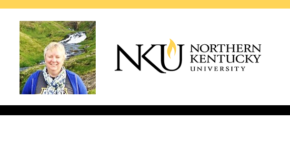 On Northern Kentucky University Week: How do we build a better book?
On Northern Kentucky University Week: How do we build a better book?
Tamara O’Callaghan, professor in the department of English, uses many different creative tools to find out.
My current research focuses on medieval manuscript design and reading practices as well as on AR (augmented reality) and VR (virtual reality) texts and narratives. I am the co-director of The Augmented Palimpsest Project, a digital humanities tool that explores how the medium of AR can be used in teaching medieval literature. This project has been funded by an NEH Digital Humanities Start-Up Grant (2014-2016).
Building a Better Book
We may know how to read a story…but how do we read, or “see,” a book?
To what extent does the physical form of the book determine our reading process?
As a medievalist and digital humanist, I am very interested in page layout and its implications for reading in relation to manuscript, print, and digital interfaces.
With the increasing presence of makerspaces (those collaborative spaces in schools, colleges, and libraries for hands-on learning with creative tools), I have wanted to explore how to build a better book for an enhanced and redesigned reading experience.
Thus my students and I are collaborating with the Clovernook Center for the Blind & Visually Impaired in Cincinnati, OH, the largest producer of braille by volume globally – 30 million pages of braille on average per year.
We are working with Clovernook on an educational outreach initiative to schools for blind and low-vision children in Kenya, Ethiopia, Rwanda, Uganda, Tanzania, Burundi, and Somalia.
Selecting culturally relevant narratives, my students create books that can seen, touched, and heard. Using the 3D printing, 3D scanning, and laser-cutting technologies in our university makerspace, they design, fabricate, test, and refine 3D artifacts that incorporate tactile and audio features. Clovernook then prints the storybooks in braille and distributes them with the 3D toolkits to schools in east Africa.
This project-based, interdisciplinary approach to the humanities, art, and technology encourages students to learn about
- Co-Design/Participatory Design – a process involving all stakeholders to ensure a fully usable and accessible end-product;
- ICT4D (Information and Communication Technologies for Development) – the application of technology to support socio-economic development and human rights in developing nations;
- Social Justice and Globalism – fostering a deep and authentic understanding of differences across cultures.
The goal? That’s simple! A multimodal tactile book that provides an inclusive and accessible reading experience for everyone.

Comments
One response to “Tamara O’Callaghan, Northern Kentucky University – Building a Better Book”